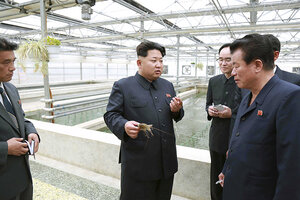Isolated and nuclear-armed, dictator Kim Jong-un keeps world on edge
A peace march across the DMZ dividing South and North Korea is due to start Sunday. But a planned visit by the UN's chief has been canceled, highlighting the regime's isolation.

North Korean leader Kim Jong Un holds a lobster at the Taedonggang Terrapin Farm in this undated photo released by North Korea's Korean Central News Agency (KCNA) in Pyongyang on Tuesday.
KCNA/Reuters
Amid claims and counterclaims between North Korea and the Pentagon about whether the regime can miniaturize nuclear weapons to fit atop a missile, North Korea has scotched a rare visit by the UN's top official.
UN Secretary General Ban Ki Moon was to visit the Kaesong industrial park on a peace mission tomorrow that would have made him the first UN chief to visit the North in more than two decades.
The ultra-secretive North gave no reason for the canceled visit by Mr. Ban, a fellow Korean. But the move underscores the isolation of dictator Kim Jong-un who took power in 2012 after the death of his father Kim Jong-il.
Earlier this month Mr. Kim canceled his own visit to Moscow for a World War II anniversary widely anticipated as his first trip abroad as leader.
Korea-watchers in Seoul and Washington remain concerned about Kim’s nuclear program, his isolation, and by reports of brutal behavior as he continues to consolidate power at home.
South Korean intelligence reported that Kim, who is widely thought to have killed his influential uncle in the fall of 2013, this spring had North Korea’s defense minister executed with an anti-aircraft gun.
North Korea said in a statement carried by its official news agency that it was capable of producing a nuclear warhead that could fit on a ballistic missile with a range that included the continental United States. It recently boasted of a successful submarine missile test.
However, Pentagon officials now say the photographs of a missile allegedly fired from a North Korean submarine were doctored and that the regime had exaggerated its claims to have made the technical leap allowing for nuclear submarine-launched missiles.
“They have not gotten as far as their clever video editors and spinmeisters would have us believe,” said Admiral James Winnefield in Washington in a Reuters report, adding that Pyongyang is “many years” away from such technology.
Some analysts argue the missile launch more likely took place from an underwater barge than a submarine.
Marches and turtles
Such reports as usual mingle with a steady stream of stories about Kim, ranging from a new hair style to an unusual proposed march this Sunday by women's peace groups led by US feminist Gloria Steinem.
This week, for example, North Korea’s leader visited a turtle farm where he expressed anger that managers had not made progress breeding lobsters, according to UPI.
The Associated Press reports that Ms. Steinem and two Nobel laureates have arrived in Pyongyang for the peace march across the Demilitarized Zone on Sunday. In a statement, the group said it had "...prioritized reunification of families, equity and justice for women living on both sides of the DMZ and a peaceful solution to the only remaining Cold War division."
Mairead Maguire and Leymah Gbowee, peace laureates from Ireland and Liberia, are among the 30 participants.
Meanwhile, a variety of US, Chinese, and South Korean intelligence sources now estimate that North Korea may have as many as 20 nuclear weapons. Last month a former South Korean official told the Monitor that the North had “up to 20” atomic devices. And while Iran has dominated Western discussions on nuclear proliferation, North Korea has tested at least two devices and has a full-fledged program.
The Wall Street Journal recently described a meeting in February between Chinese and US intelligence officials that disclosed more details about the North's program. It quoted Stanford physicist Sigfried Hecker, saying that “Some eight, nine, or 10 years ago, they had the bomb but not much of a nuclear arsenal...I had hoped they wouldn’t go in this direction, but that’s what happened in the past five years.”
CNN quotes former UN nuclear inspector David Albright who says if North Korea perfected submarine-launched missiles, that would present a threat. But it also quotes former George W. Bush administration official Victor Cha saying that eventually the North’s program could still destabilize the peninsula.
Pyongyang's advances in mobile ICBM capabilities could end up undermining the state of stable deterrence that currently exists on the Korean Peninsula," Victor Cha, Korea chair at the Center for Strategic and International Studies, wrote ... for CNN last month. "Put simply, these capabilities could give North Korea confidence that it is immune from any U.S. counter-strikes.
The Monitor wrote last month that:
North Korea under the Kim dynasty has long cherished nuclear weapons as the ultimate defense and security bargaining chip. The Kim family claims a sovereign right to govern the Korean peninsula, including the South, and under its "Military First" policy pours a large part of its budget into defense.
In the 1970s, the North sought to obtain nuclear weapons from China and the Soviet Union. When that didn't happen, it developed its own program. For part of the 1990s and early 2000s, that program was subject to UN inspections, but after a series of confrontations with the Bush administration and the UN, then-dictator Kim Jong Il pulled out of the agreement. By 2006, the North had cut loose and successfully tested a nuclear device.
Kim Jong Un succeeded his late father in 2012 and immediately carried out a successful rocket test, after a series of failures, and then in early 2013 a successful third nuclear test.

